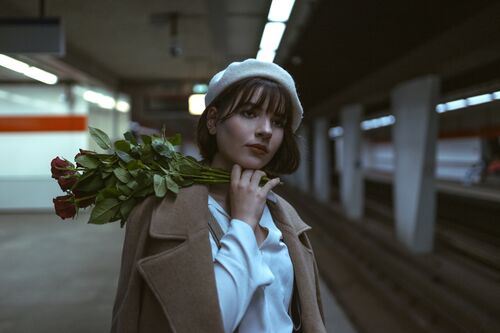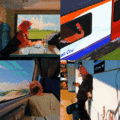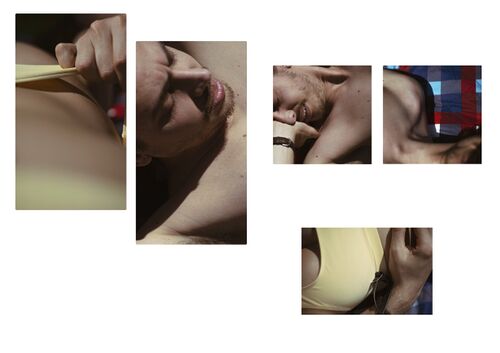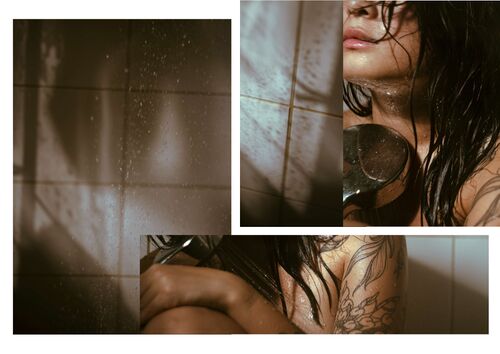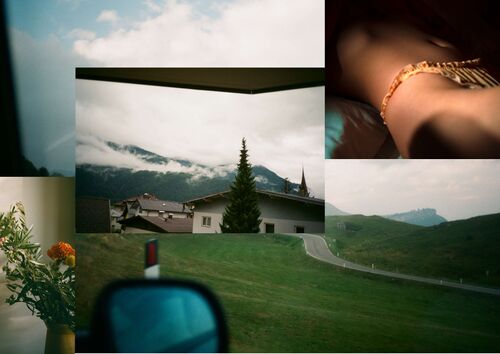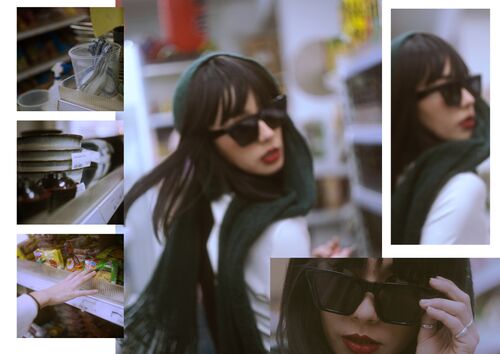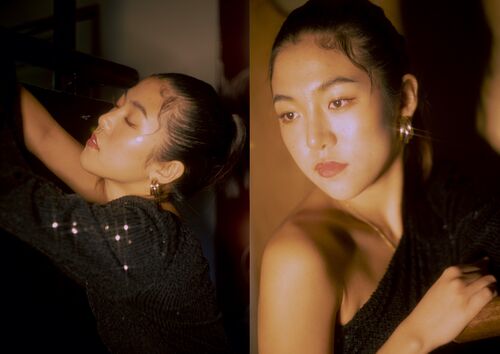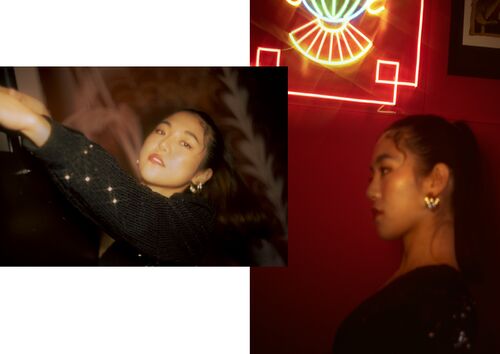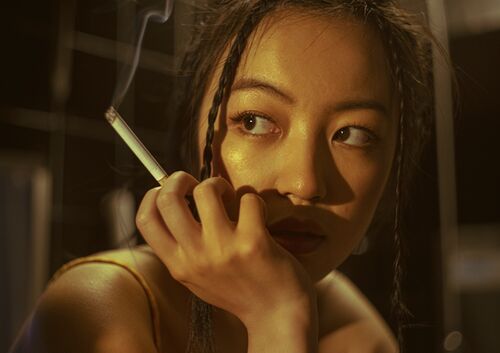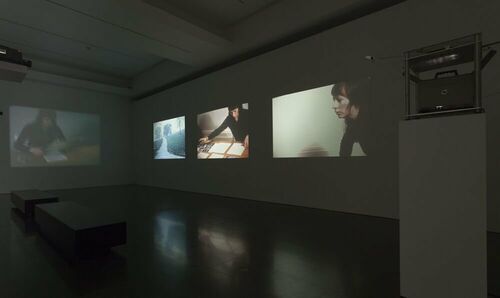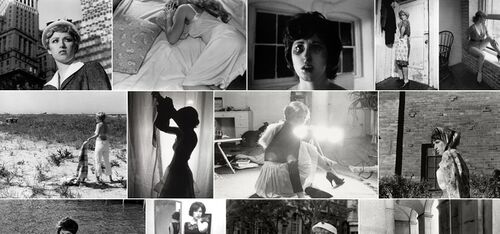User:MathildeNai/First draft chapter 1
[Steve suggests: Hi Matilde. good to see you have made a start on the thesis. I have added your project proposal below for reference because your thesis, which will be a report on your practice, will BUILD ON the project proposal. In your proposal you started to describe your work and talk about its history and relate it to other work. Here material description of what you made and why you made it will be very important, and the visuals are central to this. After the winter break I propose we work together on ways to build on the work you did for the proposal. I will ask you questions about what you have already written , and ask you to go deeper into particular issues. Workflow: It is important that you are able to write the thesis AND make work, so we need to find a way of working where the writing of the thesis does not interrupt you making the work. If in the coming months we are systematic about it the thesis can grow steadily whilst you make your work. For now, I wish you every success with your assessment next week and look forward to working with you in the new year. bst Steve]
Chapter 1: Background
In my previous work, before joining Piet Zwart Institute, I started experimenting with creating photographs that emulated film stills. My goal was to create cinematic scenes that would make my audience wonder about the characters and the stories behind them, however I found that they lacked the narrative depth that I was trying to create in my work and thus I joined Lens Based media.
[Examples] (For now all the examples are still in my project proposal.)
As I had no prior experience with looking at my work in deeper layers and with a critical eye, I had a hard time dissecting what I thought could improve my work. These are very stylised images with a lot of thought put into the location, model and fashion beforehand but what makes an image more than a pretty picture?
Analog photos
I was very set in my ways and so in my first year of Lens Based I abandoned my usual method of working and went in an entirely different direction of shooting. I took up analog photography and started shooting anything but people. This decision came from my inability to let go of any perceived perfection that I tried creating in my work — which is what made my work so risk free and boring — because I only had 36 photos on my film and I couldn’t immediately see how the photo turned out and thus I couldn’t get stuck in that loop of snapping the same picture 60 times. This helped me adopt a way of shooting that was more experimental/spontaneous in composition especially. I found that my pervious works composition was incredibly safe; it showed everything and left nothing to the imagination of the audience.
Analog images have a very nostalgic and spontaneous feeling and having them developed and analysing them helped me get a better understanding of what made them have this aesthetic and how I could better recreate them.
[Examples]
from proposal to thesis
INTIMACY * EMOTIONS * MEMORIES
A study on slice of life photography and conveying nostalgia
[This thesis will be an analysis of my own work over he past few years]
In my previous work I’ve experimented a lot with creating cinematic scenes, almost like a screenshot out of a movie. I created this with the ultimate goal of this particular analysis but at a stage where it had no actual narrative depth. I want to develop this work further and explore how to convey a narrative with only a few elements.
Key to my work will be the subject of memory; I would like to recreate moments of intimacy that provoke emotion. I want this work to have a "slice of life" element to them; by which I mean, universally relatable, specific moments that we all share. These memories will be shot and composed in the way that I remember them; fragments and details of a moment that comprise a story.
Because I'm not quite sure what the end result will look like, I will be doing lots of different experiments. In these experiments I will first try to establish a narrative in small series of images. These experiments will consist of how these images weigh up to each other within a narrative; do I need two juxtaposed photographs to tell a story or do I need many small details in order to convey what is happening? What about ratio?
Secondly I will experiment with different styles using the vocabulary of photography and cinema in order to establish what this changes in my narrative. What does lighting do to a certain mood of the photograph? What does composition do with the intensity of a scene? And what do colours tell us about a moment?
I will start with moments I have experienced; for example lying in bed with my partner. The photographs will be intimate compositions of details that fix in the memory, arranged in ways to create a narrative that conveys emotion. In this experiment I have taken several images and rearranged them to give them a narrative like above. This is the foundation that I want to build on in my project, exploring more within the realm of intimacy starting with myself as a way of warming up to these intimate compositions.
I want to draw on the visual language of cinema, such as 80s Asian cinema. These have a particular colour range; a yellow-greenish, mostly warm toned aesthetic with a high contrast and yet a softness to them. I will also draw on the influence of asian analog photographers who use a similar aesthetic of this grainy, green toned, nostalgic aesthetic. With this style, I want these images to put the viewer in a particular nostalgic place.
However I would also like to dabble in a more wholesome/summery colour palette like in the Ghibli examples in the section "Why do I want to make it" and in the movie Sideways, which has a more sunny/dreamy aesthetic to it (1). For the analog style photography I would like to reference a photographer named Emma Wondra (2).
These images will be shot digitally and colour graded and lit to have an analogue and cinematic blend style. This promotes, to me, the best of both worlds; combining my digital shooting method with the style and nostalgia of an analog look. I want these photographs to have a feeling of being a quick snapshot while at the same time being a little too dreamy and stylised to create the feeling of it being a memory that is romanticised.
I have always been moved by "slice of life" type images and artworks, there is something poetic about a piece of artwork that shows you a normal everyday scenario that you are not a part of and can still give that feeling of having been there. It gives me a feeling of now-ness while never actually having experienced that particular moment. Examples of these kinds of moments in the movies Totoro and Kiki's Delivery Service below, in which an absolutely mundane moment is captured, however I am transported to relaxing, stress free summer days.
Another big reason I want to create this type of art is because slice of life Anime was a big part of my escapism tactics in childhood. They were essentially a coping mechanism for my younger self to deal with an unstable environment by mentally transporting myself into different, more stress free and wholesome worlds where alternative scenarios played out.
This project will be my contribution to the slice of life style art. Below some screenshots of the movie Minari, which is about a Korean family in America that struggles to life off of a new farm they just moved to. While it's not spectacular in the same way that action movies are, and even though not everyone suffers the exact same struggles as they do; there is still a relatability in the way that the family is trying to keep afloat together, while still finding small hopeful moments in each other.
I hope to create the same types of artworks where the viewer can have a relatability in my work that is entirely shaped by how their life experiences are. Essentially finding common ground, despite different pasts, presents and futures.
Who can help you and how?
Right now I have found some courses on Domestika that might be beneficial to the research I am doing:
- Self-Portrait as a Personal Diary by Daniella Benedetti
- Emotive Photography: Create Real, Up-close Images by Carol Peña
Other than that I've been asked some critical questions that I struggle with and can help me closer to my goal, like:
- What makes a photograph cross the line of being more a pretty photo?
- Is this project more about mindfulness rather than the theme I am building this proposal around?
- How do I train myself to speak more about my work with deeper layers?
- Can I create a poetic layering in images without literally layering them?
- What would happen if I make this project more hyper-personal to my experiences instead of making work that I would deem "universally relatable?"
- What would happen if I dive more into the source of the "why do I want to make this?" question? (Escapism)
As I have made more of these "memory" experiments, I found that I don't necessarily know if that is the direction I want to take exactly and narratively. I would like to continue with the style references and I am very interested in creating an experience close to these memories, but perhaps not exactly that way. By asking myself these questions above, I would like to see if my project takes me in a direction that I am connected to a little bit more. Having more tutorials during my process can potentially help me unlock the "answer" I am looking for a little more,
Possible Exhibition outcomes/experiments
As for the exhibition; I would like to create a space in which it feels like the audience is "thrown" into these artificial memories that I created. I want this to feel organic and almost whimsical, like walking into a fantasy world made of memories. Therefore, I would love to eventually experiment with the following scenarios:
- Projection on Cloth (1): This would be a room where the audience would walk through a maze of cloth with projections on them as cloth is organic and the movement of the material brings a whimsy to the experience. This cloth could be a wrinkled type of linen to show the fragmentation and imperfections recalled of memories.
- Fragmented projections (2): This would be one or several walls with fragmented images projected on them. They would be changing constantly like as if you're watching someone remember different memories at once.
- Hanging polaroids (3): This installation would be comprised of lots of printed photos on thread. The audience would be walking in between them as if overwhelmed by all the life experiences and memories.
Within these installations I would be experimenting with music and lighting but do not yet know what particular lighting and music I would use as of yet and is a question I will be answering during my experiment.
Timetable
Oct-dec
- Make LOTS of prototypes, experiment all day, every day; experiment with narrative devices, find out what works and what doesn't; try out different display possibilities
- Shoot with models - main focus on developing analog style, composition experiments. Try to have a shoot every other week with the models, hoping to get more of a knack to storytelling compositions and will experiment with crops of the images in combination with each other.
- My own intimate moments - Main focus on composition.
Jan-Feb
- Shoots with models - Combine composition and style
- Start really experimenting with display possibilities
Feb-
- The work as a result of these experiments.
References/bibliography
Films
- In the Mood for Love Wong Kar-wai (2000)
- Minari Lee Isaac Chung (2021)
- My Neighbour Totoro Hayao Miyazaki (1988)
- Kiki's Delivery Service Hayao Miyazaki (1989)
- Sideways Alexander Payne (2004)
I choose these movies as my references because some of them have a "slice of life" element to them. Scenic/cinematographic and story wise I feel like they can have a relatability to different types of people because they can be interpreted in your own way, while still having a concrete idea of what is happening.
Art
*Film Script (Manipulation of Meaning)(1972) David Lamelas (1)
David Lamelas creates a "film" by projecting a series of cinematic photography slides (almost like film stills) next to each other. This relates to my project as my goal is to also create a scene by using a combination of photographs.
*Untitled Film Stills (1977-1980) Cindy Sherman (2)
In this series Cindy Sherman created self portraits in which she creates distinguished cinematic film stills. In Cindy Sherman - Untitled Film Stills, 1977-1980 Josephine Van de Walle writes: "Cindy Sherman played with the slipperiness of identity. In Untitled Film Stills, but also in all her later series, it is always Sherman herself who is in front of the camera. Yet these images are never really self-portraits. Sherman uses photography as a tool to deceive, and evades her own personality by taking on different identities." [1] This relates to my project as I am creating artificial memories and scenes that have a genuine quality to them, while at the same time being mostly, if not completely, staged.
Texts
- The Power of Now - Echkart Tolle " => [The book] presents itself as a discussion about how people interact with themselves and others. The concept of self reflection and presence in the moment."
- Once More... with Feeling: Reenactment in Contemporary Art and Culture, Robert Blackson, Art Journal Vol. 66, No. 1 (Spring, 2007), pp. 28-40 [<<you can get this text from jstor]
Cinema/TV styles
As my goal is to create cinematic stills, I also took to these works as my source of inspiration.
“In the Mood for Love" by Wong Kar Wai (2000) for example is a Chinese movie shot on film with a moody and dark feeling. “Sideways” by Alexander Payne (2004) is another movie shot on film but with a much happier and summery aesthetic. “Minari” by Lee Isaac Chung (2021) is a movie that is digitally filmed and yet has that same nostalgic feeling to it the movie as the movies mentioned before. Why? “Atlanta” a series created by Donald Glover (2016-now) is a digital series that recreates the analog style with a digital camera. “My Neighbour Totoro” (1988) and “Kiki’s Delivery Service” (1989) by Hayao Miyazaki are anime that perfectly capture the ‘slice of life’ and beauty of everyday life feeling.
While all of these works have vastly different aesthetics and stories, to me they all have one effect on me as an audience and that is a nostalgia, wether it is a sad one from In the Mood for Love or a calm and relaxing one like in Sideways.
[examples]
I have experimented with recreating the moody aesthetic of In the Mood for Love and while I do have a connection to this style; I came to the conclusion that I didn’t want my work to be dark because life isn’t dark and moody all the time.
Philosophy
While style and composition are important, another thing that I have vastly thought about in my first year of Lens Based is the philosophy of my work which is naturally closely related to the philosophy of my life.
A style or movement of art that I have always been fascinated by is the “Slice of Life” type works. Slice of life artworks are naturalistic recreations of real life, often showing mundane and uninteresting experiences.
The reason this interests me is because I have closely connected it to “The Power of Now” by Eckhart Tolle (1997) in which he describes that the ‘now’ is the time we as humans are the happiest and that it is the most important time to be in. It is about mindfulness and the beauty of the now and being aware of our surroundings physically.
Slice of life to me relates to this because in a way it also shows a ‘now’ that we have to be aware of no matter how mundane, uninteresting or maybe downright unpleasant it is to be here in the present.
At the same time Slice of life photographs can have a nostalgic effect on me as an audience which is something I am also interested in exploring.
Narrative and experiments
One direction my experimenting took me in was the recreation of memories. In which I wanted to create the nostalgic experience by creating photographs — pasted from my proposal: [The photographs will be intimate compositions of details that fix in the memory, arranged in ways to create a narrative that conveys emotion. In this experiment I have taken several images and rearranged them to give them a narrative like above]
- ↑ Josephine Van de Walle, Modern Classics: Cindy Sherman - Untitled Film Stills, 1977-1980


